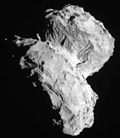67P/Churyumov–Gerasimenko
67P/Churyumov-Gerasimenko (abbreviated as 67P or 67P/C-G) is a Jupiter-family comet,[1] at first from the Kuiper belt,[2] with a current orbital period of 6.45 years, a rotation period of about 12.4 hours[3] and a maximum speed of 135,000 km/h (38 km/s; 84,000 mph).[4] Churyumov-Gerasimenko is about 4.3 by 4.1 km at its longest and widest dimensions.[5] It was first followed on photographic plates in 1969 by Soviet astronomers Klim Ivanovych Churyumov and Svetlana Ivanovna Gerasimenko, after whom it is named.[6]

It latestly came to perihelion (closest approach to the Sun) on 2 November 2021,[7][8][9] and will next come to perihelion on 9 April 2028.[10]
References
- ↑ "Department of Physics, UCF". Physics. Retrieved 2022-12-01.
- ↑ Seth, Borenstein (10 December 2014). "The mystery of where Earth's water came from deepens". AP NEWS. Retrieved 2022-12-01.
- ↑ "NASA". NASA. Retrieved 2022-12-01.
- ↑ "Frequently asked questions". www.esa.int. Retrieved 2022-12-01.
- ↑ "Bigger than you think! Comet 67P compared to cities. HD". www.youtube.com. Retrieved 2022-12-01.
- ↑ Both names are stressed on their penultimate syllable. In Ukrainian, the pronunciations are approximately churyúmow herasiménko, with the v pronounced like an English w and the g like an h.
- ↑ "67P/Churyumov-Gerasimenko". www.aerith.net. Retrieved 2022-12-01.
- ↑ "IAU Minor Planet Center". minorplanetcenter.net. Retrieved 2022-12-01.
- ↑ Kazuo, Kinoshita (7 May 2009). "67P/Churyumov–Gerasimenko". Comet Orbit. Retrieved 2022-12-01.
- ↑
67P/Churyumov–Gerasimenko Media
3D model of 67P by ESA (click to rotate)
The comet on 11 November 2021 by ZTF.
As seen by the Very Large Telescope on 11 August 2014
"NASA". NASA. Retrieved 2022-12-01.







